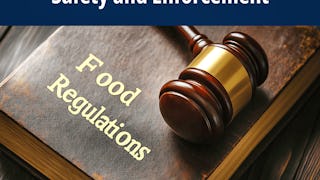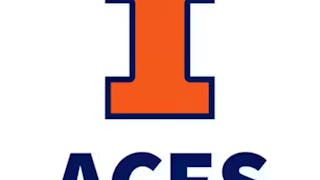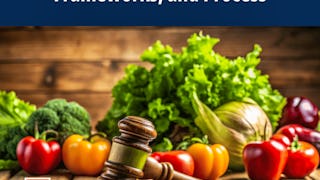Immerse yourself in the exciting realm of food regulations and labeling with our comprehensive course, perfect for learners and professionals aiming to enhance their skills. Discover the fascinating history and critical importance of food regulations and learn how key government agencies shape the food industry. Uncover the secrets behind the Nutrition Labeling and Education Act (NLEA), master the art of identifying food allergens, and explore specialty labeling options that can set products apart in the market.


Understanding Food Regulations & Food Labeling
This course is part of Personalized Nutrition, Policy, and Food Regulations Specialization

Instructor: Jessica Hartke
2,099 already enrolled
Included with
(11 reviews)
Recommended experience
What you'll learn
Understand the history, importance, and key agencies involved in US food regulation to ensure food safety and quality.
Learn the essential components of US food labels, including NLEA, allergen declarations, and specialty labeling options
Understand Nutrition Claims and Food Safety
Details to know

Add to your LinkedIn profile
6 assignments
See how employees at top companies are mastering in-demand skills

Build your subject-matter expertise
- Learn new concepts from industry experts
- Gain a foundational understanding of a subject or tool
- Develop job-relevant skills with hands-on projects
- Earn a shareable career certificate

There are 4 modules in this course
In the course orientation, you'll get to know the course, meet your classmates, explore our learning environment, and gain the technical skills you'll need. As you are introduced to Module 1, you'll learn about the critical role food regulations play in ensuring food safety, quality, and consumer protection. By the end of the module, you'll be able to explain the significance of food regulations, identify the key government agencies involved in food regulation in the U.S., and describe the main legislative acts that govern food labeling.
What's included
8 videos6 readings2 assignments1 discussion prompt
In Module 2, you’ll explore the foundational laws and regulations that shape food labeling in the U.S. We’ll introduce the Nutrition Labeling and Education Act (NLEA) and explain why it plays a key role in ensuring consumers receive accurate product information. You’ll learn how to identify the essential components of a U.S. food label, recognize the top 9 allergens, and locate them on ingredient lists. Finally, we’ll highlight specialty labeling options that provide additional details about certain food products sold in the U.S.
What's included
8 videos2 readings1 assignment
In Module 3, you will explore the different types of nutrition claims that companies can place on food labels in the U.S. From content claims to structure function claims to health claims, you’ll learn what each type of claim means, how they are regulated, and why scientific substantiation is key to ensuring they are truthful and not misleading. We’ll also walk through the process companies must follow to use or create claims, including how they gain approval. By the end of this module, you’ll understand how claims influence consumer perception and how regulatory oversight protects public health.
What's included
8 videos2 readings1 assignment
In Module 4, you will explore what it means for a food or ingredient to be “Generally Recognized as Safe” (GRAS) and how that designation is determined. You’ll also learn about key safety regulations, including Good Manufacturing Practices (GMP) and the Food Safety Modernization Act (FSMA), which help ensure the safety of the U.S. food supply. By understanding these concepts, you’ll gain insight into how food safety is maintained from production to consumption. By the end of this module, you’ll be ready to complete the final assessment and earn your Coursera certificate!
What's included
8 videos2 readings2 assignments
Earn a career certificate
Add this credential to your LinkedIn profile, resume, or CV. Share it on social media and in your performance review.
Instructor

Offered by
Explore more from Nutrition
 Status: Free Trial
Status: Free TrialUniversity of Illinois Urbana-Champaign
 Status: Free Trial
Status: Free TrialUniversity of Illinois Urbana-Champaign
 Status: Free Trial
Status: Free TrialUniversity of Illinois Urbana-Champaign
 Status: Free Trial
Status: Free TrialUniversity of Illinois Urbana-Champaign
Why people choose Coursera for their career




Learner reviews
11 reviews
- 5 stars
54.54%
- 4 stars
27.27%
- 3 stars
9.09%
- 2 stars
0%
- 1 star
9.09%
Showing 3 of 11
Reviewed on Sep 13, 2025
I really appreciate this valuable learning experience and look forward to applying it in my future professional journey.

Open new doors with Coursera Plus
Unlimited access to 10,000+ world-class courses, hands-on projects, and job-ready certificate programs - all included in your subscription
Advance your career with an online degree
Earn a degree from world-class universities - 100% online
Join over 3,400 global companies that choose Coursera for Business
Upskill your employees to excel in the digital economy
Frequently asked questions
Yes! Although completion of the Coursera course alone is not credit-bearing, it is a required component of a graduate-level Canvas course that can be counted toward advanced credentials such as an academic (transcriptable) graduate certificate or a degree. If you decide to pursue further education, the credits you earn from this course can be applied toward a formal academic program, provided that you meet all the requirements of admission to the certificate or degree.
To access the course materials, assignments and to earn a Certificate, you will need to purchase the Certificate experience when you enroll in a course. You can try a Free Trial instead, or apply for Financial Aid. The course may offer 'Full Course, No Certificate' instead. This option lets you see all course materials, submit required assessments, and get a final grade. This also means that you will not be able to purchase a Certificate experience.
When you enroll in the course, you get access to all of the courses in the Specialization, and you earn a certificate when you complete the work. Your electronic Certificate will be added to your Accomplishments page - from there, you can print your Certificate or add it to your LinkedIn profile.
More questions
Financial aid available,

